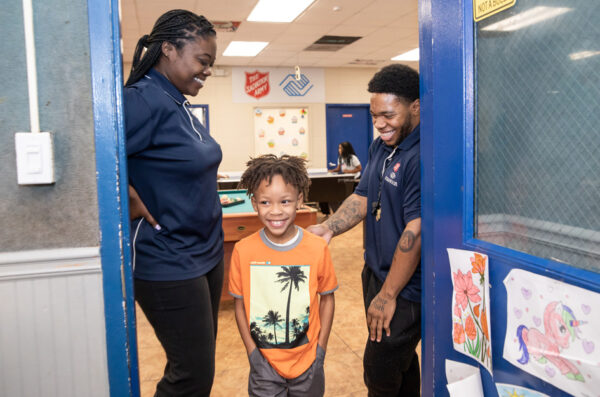Afterschool Meltdowns: Why They Happen
Kids today are feeling stressed. 71% reported to Boys & Girls Clubs of America that when something important goes wrong in their life, they can’t stop worrying about it, and when something does go wrong, they try to keep people from finding out (67%).
Young people especially have a lot going on at school. For up to six hours a day, five days a week, they’re in back-to-back classes, following rules enforced by adults and navigating social situations with peers.
Afterschool meltdowns are a natural response to these daily pressures, which can cause youth anxiety to spike at school and boil over once they’re back in a safe space where they can let their feelings out.
“Working hard to keep it together all day can be exhausting,” says Chrissy Chen, National Director, Youth Development Programs & Innovation, Boys & Girls Clubs of America. “Self-control, just like energy, is a resource we use throughout the day. That’s why we might spring for junk food, shop impulsively or binge-watch our favorite TV show after a demanding day at work. It’s no different for kids coming home from a jam-packed day at school; they just need a safe space and appropriate outlets to help decompress.”
Keep in mind that sometimes big changes in a child’s behavior after school can signal more than just low energy. Make sure to check in with young people about their mental health and be available to support them through emotionally challenging times.

Why Are We Hearing More About Afterschool Restraint Collapse?
Young people have been experiencing afterschool meltdowns for decades, but in recent years parents and caregivers have noticed an uptick in concerning youth behaviors. The term “afterschool restraint collapse” has also been gaining attention by parenting publications and social media influencers.
“Kids and teens are still adjusting to a new normal after COVID-19 lockdowns, virtual schooling and modified programming,” Chen says. “These disruptions have impacted young people’s social-emotional development, so much so that parents and caregivers are noticing more kids acting out when they’re not in school.”
Afterschool restraint collapse can happen to kids at any age. For toddlers and younger kids, it might show up as tears or a full-on floor tantrum upon arriving home. For middle and high school teens, it might look like yelling, shutting themselves into their rooms or complete exhaustion. Not every young person’s stress response looks the same, however. It’s also important to notice quieter changes too, such as a young person withdrawing from social activities or having frequent stomachaches.
And for the millions of kids who rely on afterschool programs, their afterschool meltdowns are still happening — just not at home. Boys & Girls Clubs staff pay close attention to young people’s actions, which offer clues about what youth are feeling, how their day went and what they might need to recover.
All these actions can signal when a young person is running out of self-control because they’ve been maximizing their energy all day to try and meet expectations.
Five Ways to Prevent Afterschool Restraint Collapse this Back-To-School Season
The pressures of school are year-round, but as kids and adults will tell you: back-to-school anxiety is real. Whether young people are settling into a new grade or starting at a new school, they’ll need additional empathy and support to move through this season of change.
“Afterschool restraint collapse is more likely to occur during the back-to-school season when youth are meeting new friends, learning a new teacher’s routines and returning to a more structured schedule than during the summer months,” says Erica Warren, Director of Youth Development Programming, Boys & Girls Clubs of America. “Parents and caregivers can help by scheduling time for movement and quiet as kids transition from school and maintaining a predictable routine during afterschool hours.”
Here are a few ways to help your child with back-to-school anxiety and avoid afterschool meltdowns. Every child is different, so make sure to test a few options to see what works best.

Keep Up Kids’ Summer Interests
During the summer, the school year “pressure” is off and there is a welcome focus on fun and freedom. Summertime is all about discovery — kids and teens are visiting new places, meeting new people, trying new activities. But when the school year starts back up again, it’s important not to let these newfound interests get lost or pushed to the side.
Set Up Afterschool Routines
After the flexibility of summer, getting used to a busier school schedule can be a big adjustment. To ease back-to-school anxiety, make sure youth have a relaxing afterschool routine they can look forward to and depend on at the end of the day. While homework is important, kids often need time to recharge before dipping back into academic expectations.
Whether it’s taking a neighborhood walk or doing a puzzle for 20 minutes, setting up time for youth to unwind after school lets them know that no matter what the school day may bring, they will always have time to decompress. While kids will miss the carefree days of summer, keeping up routines will give them the consistency they need to prevent afterschool meltdowns.
Did You Know?
To help kids mentally shift from school, Boys & Girls Clubs may lead a signature chant or cheer to kick off their afternoon and let some of that stressed energy out. They also offer healthy snacks as a daily checkpoint or run recurring activities kids can count on, like “Stop The Boat”, a Club community building activity and alphabet game

Create a Calming Environment
If you notice kids coming back from school feeling exhausted, restless or overwhelmed, set up a special space where they can let their guard down and relax. Spending time in these spaces can be part of their afterschool routine, where they can go to work on a quiet activity, practice a guided meditation or read.
Use music and soft lighting to create a relaxing environment to help calm back-to-school anxiety for kids. You can also fill the space with tangible, creative materials to give young people an outlet for channeling their emotions. These might include stress balls, fidget toys, putty, coloring books or journaling prompts.
Get Up and Moving
Exercising while you’re anxious is like tricking your mind and body — suddenly all those anxiety symptoms like a racing heart, sweaty palms and fast breathing are just a normal response to your body in motion. Plus, you get the double benefit of releasing stress and feeling mood-boosting endorphins.
To avoid afterschool meltdowns and help youth regain control over anxious thoughts, schedule time for them to get up and move after school. Find a physical activity they enjoy and make it easy to engage in. This can be as organized as afterschool team sports or as lowkey as a family walk or dance break.
Did You Know?
At Clubs, kids and teens are encouraged to channel any lingering restlessness from school into group games, activities, and sports. This can not only relieve back-to-school anxiety, but also lead to deeper sleep and concentration, allowing youth to start the school day well-rested and ready to learn.

Facilitate Emotional Check-Ins
Instead of trying to guess what’s going on in a young person’s brain, simply ask them — and trust their responses — during emotional check-ins.
Emotional check-ins give youth the opportunity to pause, reflect and identify their emotions. They also allow you to get a better understanding of how they’re feeling and identify ways to support them.
Checking in with your emotions is a skill, so it may take some practice working with your child to learn the vocabulary of describing how they’re feeling. Creative ways to do emotional check-ins might be asking them to relate their emotions to the weather, an emoji, a food or an animal that represents how they feel. You might also ask them about some of their great experiences from summer and what they want to accomplish in the upcoming school year.
By taking the time to show kids and teens that their feelings matter to you, you’ll not only strengthen your relationship, but also build their self-esteem to combat back-to-school anxiety.
Back-to-school season can be intimidating, but it doesn’t have to be overwhelming.
“None of us have an unlimited reserve of self-control,” says Chen. “Whether it’s a warm welcome to an afterschool environment, a space to decompress or opportunities for exercise or a snack, offering youth ways to physically, mentally and emotionally transition from school to after school can build skills for self-regulation that prevent afterschool restraint collapse.”
By setting youth up with the routines, spaces and tools to regulate their emotions, you can empower them to let nothing stand in their way of having a great school year!
Raise Your Hand for Great School Years
Boys & Girls Clubs provides thousands of young people each year with the mentorship, meals, and meaningful life experiences that they need to thrive – in school and out. Join us on our mission of helping all young people reach their full potential and donate today.








